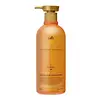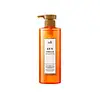What's inside
What's inside
 Key Ingredients
Key Ingredients

 Benefits
Benefits

 Concerns
Concerns

 Ingredients Side-by-side
Ingredients Side-by-side

Water
Skin ConditioningSodium C14-16 Olefin Sulfonate
CleansingCoco-Betaine
CleansingGlycerin
HumectantButylene Glycol
HumectantDecyl Glucoside
CleansingCocamide Mea
EmulsifyingMethylpropanediol
SolventVincetoxicum Atratum Extract
Skin ConditioningGuar Hydroxypropyltrimonium Chloride
Skin ConditioningPanthenol
Skin ConditioningSalicylic Acid
MaskingCitric Acid
BufferingDisodium EDTA
Niacinamide
SmoothingCaprylhydroxamic Acid
Ethylhexylglycerin
Skin ConditioningArginine
MaskingLeucine
Skin ConditioningTryptophan
MaskingLysine
Skin ConditioningIsoleucine
Skin ConditioningThreonine
Methionine
Skin ConditioningHistidine
HumectantAsparagine
MaskingAlanine
MaskingProline
Skin ConditioningGlutamic Acid
HumectantGlutamine
Skin ConditioningValine
MaskingPhenylalanine
MaskingAspartic Acid
MaskingTyrosine
MaskingSerine
MaskingCystine
MaskingRehmannia Chinensis Root Extract
Skin ConditioningCornus Officinalis Fruit Extract
Skin ConditioningDioscorea Japonica Root Extract
Skin ConditioningAlisma Orientale Tuber Extract
Skin ConditioningPoria Cocos Sclerotium Extract
AstringentPaeonia Suffruticosa Extract
Skin ConditioningHamamelis Virginiana Leaf Extract
Skin ConditioningSalvia Officinalis Leaf Extract
CleansingMelissa Officinalis Leaf Extract
Skin ConditioningMentha Piperita Extract
CleansingLavandula Angustifolia Extract
Skin ConditioningHouttuynia Cordata Extract
Skin ConditioningEucalyptus Globulus Leaf Extract
PerfumingGlycine Max Seed Extract
Skin ConditioningZingiber Officinale Root Extract
MaskingCurcuma Longa Root Extract
MaskingLinalool
PerfumingGeraniol
PerfumingParfum
MaskingWater, Sodium C14-16 Olefin Sulfonate, Coco-Betaine, Glycerin, Butylene Glycol, Decyl Glucoside, Cocamide Mea, Methylpropanediol, Vincetoxicum Atratum Extract, Guar Hydroxypropyltrimonium Chloride, Panthenol, Salicylic Acid, Citric Acid, Disodium EDTA, Niacinamide, Caprylhydroxamic Acid, Ethylhexylglycerin, Arginine, Leucine, Tryptophan, Lysine, Isoleucine, Threonine, Methionine, Histidine, Asparagine, Alanine, Proline, Glutamic Acid, Glutamine, Valine, Phenylalanine, Aspartic Acid, Tyrosine, Serine, Cystine, Rehmannia Chinensis Root Extract, Cornus Officinalis Fruit Extract, Dioscorea Japonica Root Extract, Alisma Orientale Tuber Extract, Poria Cocos Sclerotium Extract, Paeonia Suffruticosa Extract, Hamamelis Virginiana Leaf Extract, Salvia Officinalis Leaf Extract, Melissa Officinalis Leaf Extract, Mentha Piperita Extract, Lavandula Angustifolia Extract, Houttuynia Cordata Extract, Eucalyptus Globulus Leaf Extract, Glycine Max Seed Extract, Zingiber Officinale Root Extract, Curcuma Longa Root Extract, Linalool, Geraniol, Parfum
Water
Skin ConditioningSodium C14-16 Olefin Sulfonate
CleansingCocamidopropyl Betaine
CleansingGlycerin
HumectantPyrus Malus Fruit Extract
Skin ConditioningVinegar
Decyl Glucoside
CleansingVitis Vinifera Fruit Extract
Skin ConditioningRoyal Jelly Extract
Skin ConditioningPersea Gratissima Fruit Extract
EmollientHippophae Rhamnoides Fruit Extract
Skin ConditioningSaccharum Officinarum Extract
MoisturisingMelaleuca Alternifolia Leaf Extract
PerfumingOlea Europaea Fruit Extract
BleachingDaucus Carota Sativa Root Extract
Skin ConditioningPrunus Mume Fruit Extract
HumectantRubus Chamaemorus Fruit Extract
AntioxidantHibiscus Sabdariffa Flower Extract
Skin ConditioningLuffa Cylindrica Fruit Extract
Skin ConditioningActinidia Chinensis Fruit Extract
EmollientCitrus Limon Fruit Extract
MaskingAdansonia Digitata Seed Extract
Skin Conditioning1,2-Hexanediol
Skin ConditioningCaprylhydroxamic Acid
Ethylhexylglycerin
Skin ConditioningMethylpropanediol
SolventSodium Chloride
MaskingPolyquaternium-10
Allantoin
Skin ConditioningGuar Hydroxypropyltrimonium Chloride
Skin ConditioningDisodium EDTA
Cocamide Mea
EmulsifyingCynanchum Atratum Extract
Skin ConditioningCitric Acid
BufferingParfum
MaskingWater, Sodium C14-16 Olefin Sulfonate, Cocamidopropyl Betaine, Glycerin, Pyrus Malus Fruit Extract, Vinegar, Decyl Glucoside, Vitis Vinifera Fruit Extract, Royal Jelly Extract, Persea Gratissima Fruit Extract, Hippophae Rhamnoides Fruit Extract, Saccharum Officinarum Extract, Melaleuca Alternifolia Leaf Extract, Olea Europaea Fruit Extract, Daucus Carota Sativa Root Extract, Prunus Mume Fruit Extract, Rubus Chamaemorus Fruit Extract, Hibiscus Sabdariffa Flower Extract, Luffa Cylindrica Fruit Extract, Actinidia Chinensis Fruit Extract, Citrus Limon Fruit Extract, Adansonia Digitata Seed Extract, 1,2-Hexanediol, Caprylhydroxamic Acid, Ethylhexylglycerin, Methylpropanediol, Sodium Chloride, Polyquaternium-10, Allantoin, Guar Hydroxypropyltrimonium Chloride, Disodium EDTA, Cocamide Mea, Cynanchum Atratum Extract, Citric Acid, Parfum
 Reviews
Reviews

Ingredients Explained
These ingredients are found in both products.
Ingredients higher up in an ingredient list are typically present in a larger amount.
Caprylhydroxamic Acid is a chelating agent.
Chelating agents help prevent metal ions from binding to other ingredients. This helps prevent unwanted reactions and effects from using the product.
Caprylhydroxamic Acid is often used with natural antimicrobial products as an alternative to preservatives.
Learn more about Caprylhydroxamic AcidCitric Acid is an alpha hydroxy acid (AHA) naturally found in citrus fruits like oranges, lemons, and limes.
Like other AHAs, citric acid can exfoliate skin by breaking down the bonds that hold dead skin cells together. This helps reveal smoother and brighter skin underneath.
However, this exfoliating effect only happens at high concentrations (20%) which can be hard to find in cosmetic products.
Due to this, citric acid is usually included in small amounts as a pH adjuster. This helps keep products slightly more acidic and compatible with skin's natural pH.
In skincare formulas, citric acid can:
While it can provide some skin benefits, research shows lactic acid and glycolic acid are generally more effective and less irritating exfoliants.
Most citric acid used in skincare today is made by fermenting sugars (usually from molasses). This synthetic version is identical to the natural citrus form but easier to stabilize and use in formulations.
Read more about some other popular AHA's here:
Learn more about Citric AcidWe don't have a description for Cocamide Mea yet.
Decyl Glucoside is a glucose-based surfactant and emulsion stabilizer. It is created by reacting glucose with the fatty acids from plants.
Surfactants help clean the skin by trapping oil, sebum, and dirt to be washed away. As an emulsion stabilizer, it stabilizes the ingredients in a product by preventing them from separating.
This ingredient is biodegradable and non-toxic. This ingredient is commonly found in baby shampoos.
Decyl Glucoside is sometimes used to stabilize the UV filter Tinosorb.
Learn more about Decyl GlucosideDisodium EDTA plays a role in making products more stable by aiding other preservatives.
It is a chelating agent, meaning it neutralizes metal ions that may be found in a product.
Disodium EDTA is a salt of edetic acid and is found to be safe in cosmetic ingredients.
Learn more about Disodium EDTAEthylhexylglycerin (we can't pronounce this either) is commonly used as a preservative and skin softener. It is derived from glyceryl.
You might see Ethylhexylglycerin often paired with other preservatives such as phenoxyethanol. Ethylhexylglycerin has been found to increase the effectiveness of these other preservatives.
Glycerin is already naturally found in your skin. It helps moisturize and protect your skin.
A study from 2016 found glycerin to be more effective as a humectant than AHAs and hyaluronic acid.
As a humectant, it helps the skin stay hydrated by pulling moisture to your skin. The low molecular weight of glycerin allows it to pull moisture into the deeper layers of your skin.
Hydrated skin improves your skin barrier; Your skin barrier helps protect against irritants and bacteria.
Glycerin has also been found to have antimicrobial and antiviral properties. Due to these properties, glycerin is often used in wound and burn treatments.
In cosmetics, glycerin is usually derived from plants such as soybean or palm. However, it can also be sourced from animals, such as tallow or animal fat.
This ingredient is organic, colorless, odorless, and non-toxic.
Glycerin is the name for this ingredient in American English. British English uses Glycerol/Glycerine.
Learn more about GlycerinThis ingredient is derived from guar gum.
It is a conditioning ingredient, meaning it helps soften skin and hair.
Methylpropanediol is a synthetic solvent and humectant.
As a solvent, it helps dissolve other ingredients, helping to evenly distribute ingredients throughout the product. This ingredient has also been shown to have antimicrobial properties which makes it a preservative booster.
Methylpropanediol is able to add a bit of moisture to the skin. It also helps other ingredients be better absorbed into the skin, such as salicylic acid.
Learn more about MethylpropanediolParfum is a catch-all term for an ingredient or more that is used to give a scent to products.
Also called "fragrance", this ingredient can be a blend of hundreds of chemicals or plant oils. This means every product with "fragrance" or "parfum" in the ingredients list is a different mixture.
For instance, Habanolide is a proprietary trade name for a specific aroma chemical. When used as a fragrance ingredient in cosmetics, most aroma chemicals fall under the broad labeling category of “FRAGRANCE” or “PARFUM” according to EU and US regulations.
The term 'parfum' or 'fragrance' is not regulated in many countries. In many cases, it is up to the brand to define this term.
For instance, many brands choose to label themselves as "fragrance-free" because they are not using synthetic fragrances. However, their products may still contain ingredients such as essential oils that are considered a fragrance by INCI standards.
One example is Calendula flower extract. Calendula is an essential oil that still imparts a scent or 'fragrance'.
Depending on the blend, the ingredients in the mixture can cause allergies and sensitivities on the skin. Some ingredients that are known EU allergens include linalool and citronellol.
Parfum can also be used to mask or cover an unpleasant scent.
The bottom line is: not all fragrances/parfum/ingredients are created equally. If you are worried about fragrances, we recommend taking a closer look at an ingredient. And of course, we always recommend speaking with a professional.
Learn more about ParfumSodium C14-16 Olefin Sulfonate is a cleansing agent made from a mixture of long chain sulfonate salts. It can also help produce foam.
This ingredient may be drying. We recommend speaking with a professional if you have concerns.
Water. It's the most common cosmetic ingredient of all. You'll usually see it at the top of ingredient lists, meaning that it makes up the largest part of the product.
So why is it so popular? Water most often acts as a solvent - this means that it helps dissolve other ingredients into the formulation.
You'll also recognize water as that liquid we all need to stay alive. If you see this, drink a glass of water. Stay hydrated!
Learn more about Water